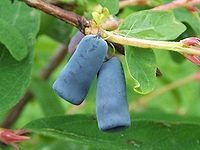
Photo from wikipedia
Cornelian cherry is a wild fruit contains considerable amounts of bioactive compounds such as ascorbic acid, anthocyanins, and phenolics. It has many different health beneficial effects due to these bioactive… Click to show full abstract
Cornelian cherry is a wild fruit contains considerable amounts of bioactive compounds such as ascorbic acid, anthocyanins, and phenolics. It has many different health beneficial effects due to these bioactive compounds. In the present study, convective drying and refractance window drying was employed in cornelian cherry pulp drying under different drying conditions. Moisture content (8.03–8.27 g/100 g), water activity (0.350–0.354), color properties, total monomeric anthocyanin content (247.47–347.3 mg C3G/kg dm), ascorbic acid content (0.81–0.90 g/kg dm), radical scavenging activity (0.87–1.47 g TEAA/kg dm), and 5‐hydroxymethylfurfural (18.80–24.10 mg/l) content of the powders were determined. According to the results, physicochemical properties of the samples produced by refractance window drying were better than those of convective drying. Higher drying temperatures and air velocities provided higher content of total monomeric anthocyanin content and radical scavenging activity in hot air drying. However, drying temperature was found to be ineffective on all tested parameters in refractance window dried samples. Overall, refractance window drying of cornelian cherry pulp at 90 °C is recommended to achieve good physicochemical properties. PRACTICAL APPLICATIONS: Refractance window drying is an innovative drying system usually used in the drying of liquid and semi‐liquid foods. The results have shown that refractance window drying provided better physicochemical properties than convective drying in very short drying time.
Journal Title: Journal of Food Process Engineering
Year Published: 2018
Link to full text (if available)
Share on Social Media: Sign Up to like & get
recommendations!